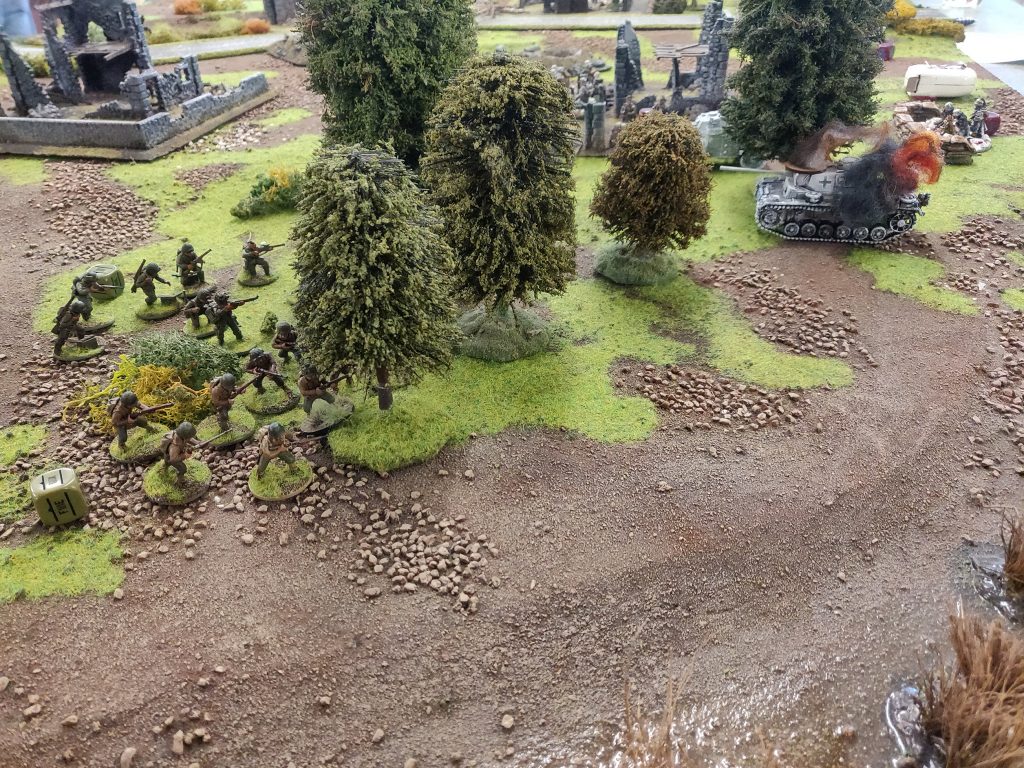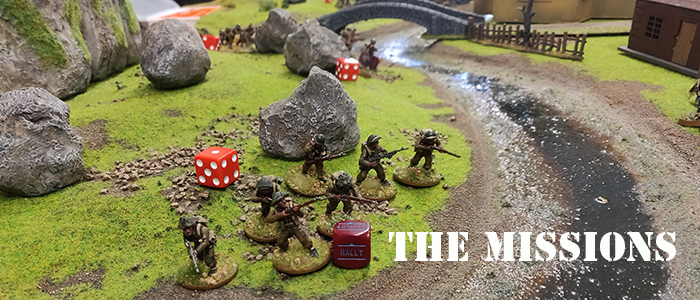Bolt Action Team Challenge 2019 Introduction
Current teams line up
Team and selection rules
What to bring
The rounds
The tables and missions
Event details
Schedule 12th May 2019
Lunch
Location and contact
Staying overnight
Awards
Entry cost
Scoring
Bonus points (4 points maximum)
Match point scoring (15 points maximum available)
Secondary objective (three points available in total)
Special missions (three points available in total)
A note on Objectives
The Missions
Major rule mechanics changes/ clarifications
Table one – Train service disruption (objective mission)
Table two – A tale of two City blocks (Quadrants movement mission)
Table three – Rear guard action (attack/ defend mission)
Table four – Probes (objective mission)
Table five – Break out (Movement mission)
Table six – Russian wave tactics (attrition mission)
Table seven – Tank vandals (demolition/ objective mission)
Table eight – Hold until relieved (attack/defend mission)
Table nine – Road ambush (Movement mission)
![]() Download Full SSWG Bolt Action Team Challenge 2019 document Here
Download Full SSWG Bolt Action Team Challenge 2019 document Here
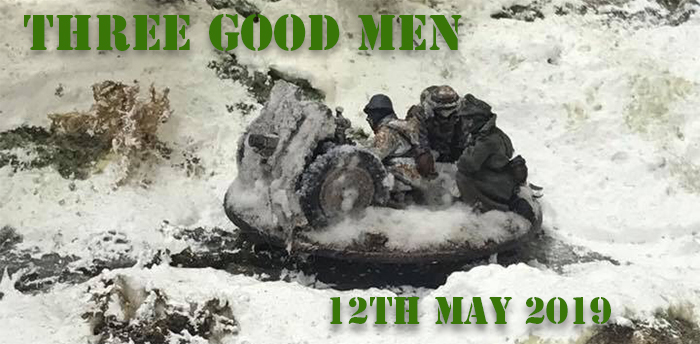

![]()
![]()
![]()
![]()
Three Good Men 12th May 2019
Introduction
Three Good men is SSWG’s annual Bolt Action tournament. It is a team based event, with teams of
three players and is very much historically themed with restrictions on lists to reduce the risk of
mismatches. Lists will be arranged to ensure no blue on blue games occur. The tourney is played
over one day at our club house on pre prepared tables and is by invite only. This will be the second
time we have run the event and to reflect that we have expanded slightly to allow an additional team.
We have also added scoring options to increase the fun of the games.
Once a team has signed up we respectfully ask the team captain to ensure three players in total attend as substitutes may not be available on the day.
Current teams line up
- Hackney Area Tabletop Enthusiasts
- SSWG KampfGruppe (Southend)- Axis
- Alpha Pathfinders (Ipswich)- Allies
- East coast wargames club
- Surrey Spartans- Axis
- Colchester Crusaders
Team and selection rules
Three players per team with one captain for each team
The team will use armies from the same side, so all Axis or Allies, no mixing. This is to be agreed with
the TO ahead of the tourney 1000 point single platoons to be used, no tank platoons allowed and only one platoon (to stop the spamming of units and to reduce the risk of mismatches)
Dice limit will be in place with a minimum of 8 and maximum of 16
Lists must be historically accurate and themed, they must be selected from a Bolt Action army book
including generic (but still themed). Accurate means, for example, not mixing weapon systems with
troops that never fought with each other or using a unit that was rare to the point of being a unicorn
(Maus!).
TO retains the right to rule out some choices for the sake of game balance, we are looking for fun games and the best players, not the best lists!
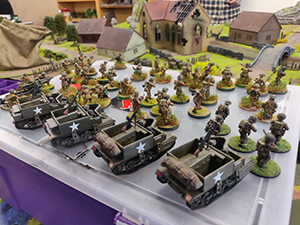

All armies must be painted, but any standard is acceptable
The army must be picked from an army book and not a campaign book or PDF release (exceptions will be made for some where lists are historical and not OP but please check first). If it is generic it still has to be historically credible.
- 2x copies of your army list
- Dice, order dice, tape measures, templates, dice bag and some spare order dice if possible of a different colour
- Rules book and the army book being used
- Please make a note of units worth over 200 and 300 points
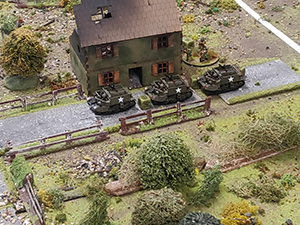

Captains will be shown each-others team’s army lists and will roll off.
The winner of the roll off picks a table from the three available and then picks his first player, the opponent captain then selects his player to counter and play against that opponent.
The above process is repeated with the roll off loser this time going first
Final match-up is the remaining table and players.
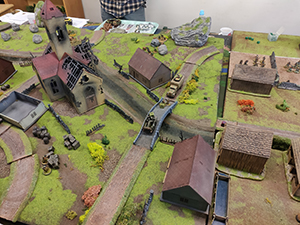

The tables will be designed to be themed for the missions played and for the set up zones.
The missions will be based around the 12 in the core rule book for Bolt Action with some adjustments, so please read the missions as they will differ to the book.
There will always be a secondary objective on the table (see below)
- Doors open at 9am
- Registration from 9am and pre game instruction 9.45am
- First round at 10am to 12.20pm
- Lunch 12.20pm to 1pm (we will look to provide bacon rolls at a small charge)
- Second round 1pm to 3.20pm
- Third round 3.35pm to 5.55pm
- Final scores and awards from 6pm
SSWG will arrange bacon rolls and there is a tuck shop with snacks and drinks at the event.
SSWG club house
Sswg.co.uk
3a Bentalls Close
Southend on Sea
Essex SS2 5PT
The club house is just in front of St Anns builders merchants, gates to the left as you approach it at
the end of the close.
Any problems call Russ on 07703 773 781
Club house is “marked” below:
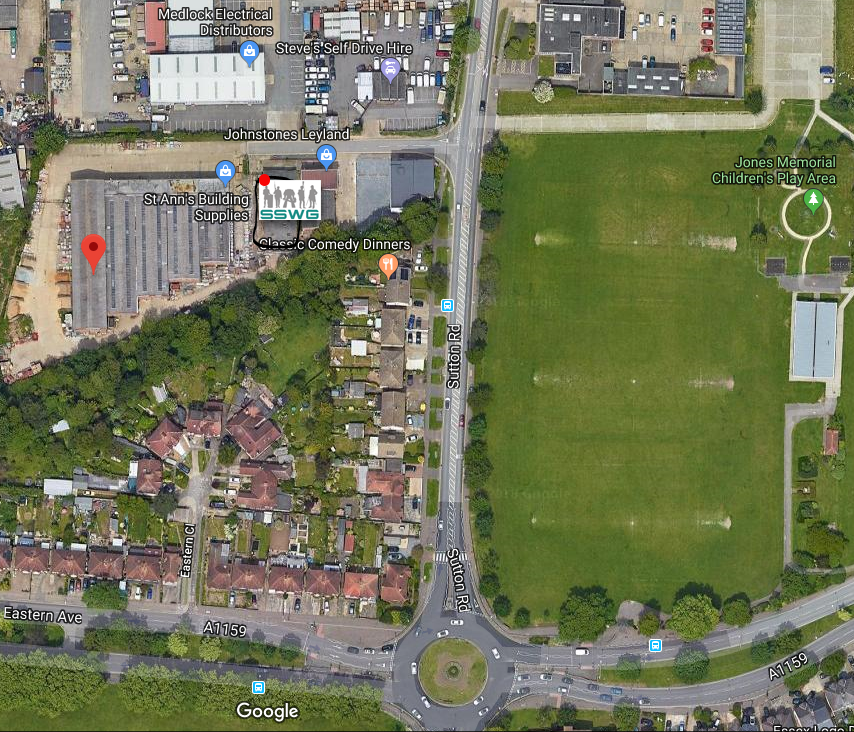

We have recently expanded the parking area in front of the club house and have room for about five
cars, so please car pool where possible. Parking will also be available at St Anns Building Supplies
but please park at back of the car park, furthest away from the doors, and contact me to arrange this
on number above.
Trains-We are very close to Prittlewell train station and not far from Southend Central- if a team wants
to come by train we will arrange collection at the train station and return.
Our nearest airport is London Southend Airport!
Staying overnight
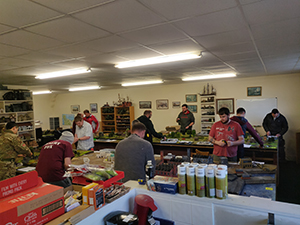

Alternatively, there is a good chance members of SSWG can help out by finding spare rooms for those wanting to arrive Friday night. Be warned that you will likely be dragged out to our local pubs that evening!
Awards
Team award based on highest scoring team (maximum of 75 points)
Best general award (most individual points scored)
£10 entry
Will be used to cover prizes and overheads
There are four ways to score points in the tourney:
- Bonus points for meeting tourney requirements.
- Match play results.
- Secondary objectives.
- Side missions.
A total of 25 points is available per player.
Bonus points (4 points maximum)
Real army- Army list is historical on a particular front at a particular time- one point per list.
Real unit- Army list is based on an actual unit and is realistic- one point per list.
Timeliness- one bonus point for lists in on time.
Painted- the army is painted to any standard (this doesn’t mean just undercoated!)- one point per list.
So a maximum 12 points per team is available (getting this right is worth more than two wins); all
bonuses at TO’s discretion
Example of a maximum scoring list
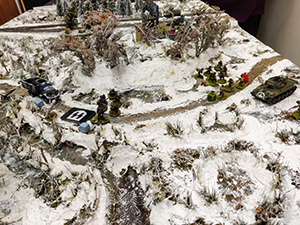

Match point scoring (15 points maximum available)
Five points for the win
Two points for the draw
One point for a loss (chin up award!)
One point for the secondary objective
Zero points for a concession and all order dice are assumed to be destroyed (so don’t concede!)
Note on concessions
Unless it’s agreed by both players and the TO, who may choose to assign further order dice
casualties then conceding means you will score zero rather than one point. All your units are
considered to have surrendered and so your opponent would score all the order dice as killed.
Tiebreakers will be settled if needed with enemy order dice destroyed only and not on losses, we
want to encourage aggressive play.
Secondary objective (three points available in total)
Score one point for holding a secondary at the end of a game, uncontested by an enemy infantry or
artillery unit. This has to be done in the same way as for normal objectives (see below)
Special missions (three points available in total)
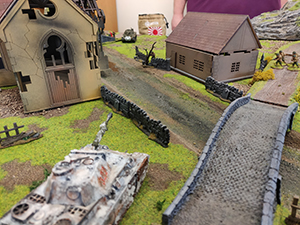

- Decapitation- Kill an enemy officer during the game
- Reckless bravery- Do not use a down order during the game
- Charge!!!!- destroy an enemy unit with an assault order
- Wheels of terror- Destroy an enemy armoured vehicle (anything with armour 7+) with an infantry
AT weapon (eg Panzerfaust, PIAT) - Everybody in- Play a game with no reserves used
- Tank shield- Destroy an enemy armoured vehicle (anything with armour 7+) with an AT or
artillery piece. - Tank shock- Assault an enemy unit with a tank (vehicle with AV 7+)
- No prisoners- Destroy 75% of the enemy force by order dice
- Shell shock- Destroy an enemy unit with pins (not a failed morale test but pins exceeding
leadership) - Withering fire- destroy an enemy unit with an infantry MMG
A note on Objectives and dice killed
All objectives are 40mm in diameter, including secondary and are pre –placed and should not be
moved on the battle map.
Secondaries will also be placed on the board and will be the same as normal objectives.
With regards to dice killed, if you destroy a unit that is worth 200-299 points then this is worth two dice when chalking up the dice count. If the unit is worth over 300 points then it is worth 3 dice for dice counts. This is used on all missions.
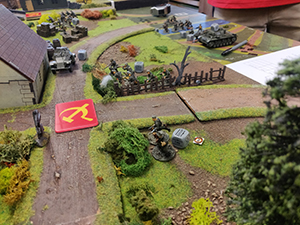

Occupied transports would need to debus their occupants to allow those occupants to claim/ contest the objective.
Note that infantry does not include spotters or medics or chaplains but does include forward observers, MMG units etc.
To be within three inches of an objective you must be on the same level as the objective eg on the
ground for a ground placed objective or on the correct floor of a building.
Major rule mechanics changes/ clarifications
There is no Tiger fear for PZ IVs (to encourage use of tanks other than PZ IVs)
There is no turret jam (unnecessary and often forgotten rule)
Observers can not secure objectives and are removed from board if the artillery piece they are
spotting for is removed (clarification).
Medics also can not secure objectives (forward observers can).
Line of site- Playing real line of site but you have to be able to see the chassis or turret of the vehicle,
just a barrel, track or fender etc is not enough. If unsure roll off or check with the TO. We will use the
periscope to make judgements!
Intervening cover- If the firer is in an elevated position and can see over the terrain (eg in a building
first floor) there is no intervening terrain unless target is within an inch of the cover. If the firer and
target are at the same level as each other, then intervening cover is in place. So a stone wall between
you and the target provides -2 hard cover, unless you are within an inch of it.
Line of site is drawn from the breech of the firing weapon and distance is measured from the breech.
Trees and high hedges are considered to block line of site if a unit is behind rather than in the cover,
even though you can see the unit through tree gaps. Also LOS can not be drawn through a building
window (unless you are in the building!). This is true of ruins also when treated as dense terrain.
Snipers can not kill team weapon squads unless they are down to two men/ started with two men.
(This is to make MMG teams more practical).
Table one – Train Service Disruption (objective mission)
Set up
Players take designated sides, all units start off the board except for forward deployers who are
placed on the board but may not be on the other side of the rail tracks from their own side.
There is no prelim bombardment, the Allies do not want to risk damaging the train line, the Axis does
not have Arty support available in this sector.
Flanking is allowed
Objective/ synopsis
An Allied logistics train carrying components of an armoured division scheduled to lead the push is
scheduled to be on the railway track in this sector within the next three hours. Unfortunately Axis
aerial recon has spotted it. Allies hold air supremacy and so instead of an air strike a spoiling force
has been sent to the rail line to attempt to stop or slow this critical train. Ally forces in the area have
been dispatched to secure the rail track in this section.
Secure the objectives on the train line (three).
First turn
Battle begins, both players must bring at least half of their units onto the table edge (rounding up) with
no order test needed. Other units may be in reserve.
Duration
Six turns but at the end of turn six a dice is rolled and on a four plus the game enters a final seventh
turn.
Victory
The player controlling the most objectives win, if the same number are controlled than if either player
has destroyed two or more order dice than their opponent than they win, forcing their weakened
enemy to withdraw from the battlefield, otherwise the result is a draw.
Other important notes
There is a single secondary objective on the map. This does not count towards objectives in the game
but does score one point to your overall total.
No prelim bombardment
The Railway line provides light cover for infantry and artillery as it’s on a slight embankment, but no
cover for vehicles which are too high and can be clearly seen.
Table two – A tale of two City blocks (Quadrants movement mission)
Set up
Take your designated table edge
The table is divided into quarters, The Axis player’s quarter is the one on the left hand side of his
table edge as is the Allied player’s.
The Axis player sets up at least half of his units within his quarter at least 12’ from the centre point of
the table. These units may begin the game in hidden set up. Other units will begin the game in
reserve and may NOT flank in this game.
The Allied player than does the same.
Forward deployment is allowed and these units may start in the other quadrant to the right.
The Axis player will deploy any forward deployer first and turns then alternate.
Prelim bombardments do come in for both players automatically
No flanking
Objective/ synopsis
A vicious street fight has broken out in this heavily shelled and defended town with both sides fighting
as much for survival as victory. Securing outflanking sections will be critical to the victory.
Duration
Six turns but at the end of turn six a dice is rolled and on a four plus the game enters a final seventh
turn.
Victory
At the end of the game calculate which side has won by adding up victory points as follows.
- Enemy unit destroyed 1 VP
- Unit is completely inside one of the neutral quarters 1 VP, empty transports/tows do not count
but if a unit is inside it would count (so transport with a passenger is 1 point only, not 2) - Unit is completely inside the opponents quarter of the table 3 VP (same restriction on
transports/tows as above)
If a player has won by 2 or more VPs then they have won, otherwiseresult is a draw.
Other important notes
Make sure you understand how the VP work
All terrain with the exception of inside ruins (which is rough) is considered normal terrain for
movement purposes.
Roads act normally but roadblocks prevent unarmoured vehicles advancing. If an armoured vehicle
moves through it the road block is removed from play.
Table three – Rear guard action (attack/ defend mission)
Set up
Players take designated sides, the Allied player is the attacker. Three objectives have been placed,
one within 6’ of the table centre and the other two within the diagonal table half created by the Axis
player’s short and long table edges/ Objectives will be at least 12’ apart and 12’ from any table ledge.
If in a building the player must hold the ground floor to hold the objective, units on the first floor do not
count. If set on fire then neither player can secure the objective.
Forward deployment is allowed in own diagonal but Allied units must not be within 15’ of an enemy
unit. The Axis player deploys first and then turns alternate.
Prelim bombardments occur for the Allied player only and is automatic
Firstly
The Axis player sets up at least half (round up) of his units within the diagonal half of the table formed
by his table edge and the short side to his right. These units begin the game in hidden set up. Other
units will begin the game in reserve and may flank but only on the Axis right hand side.
Secondly
The Allied player sets up at least half of his infantry (not vehicles or artillery but fixed/ team weapons
teams are OK) in his diagonal half of the board at least 15’ from any enemy unit. Any of the Allied
player’s units not on the board may enter on turn one as part of a first wave, everything else is in
reserve and may outflank but only on the Allied players right hand side.
Forward deployment is allowed
Objective/ synopsis
Axis forces have been forced onto the retreat. Blocking forces have set up a defensive line to delay
the Allied pursuit and allow their comrades to withdraw safely to a new defensive line.
First turn
Battle begins, both players must bring at least half of their units onto the table edge (rounding up) with
no order test needed. Other units may be in reserve.
Duration
Six turns
Victory
The player controlling the most objectives win, if the same number are controlled than if either player
has destroyed two or more order dice than their opponent than they win, forcing their weakened
enemy to withdraw from the battlefield, otherwise the result is a draw.
Other important notes
Set up is unusual in that the board is split diagonally.
Table four – Probes (objective mission)
Set up
Players take designated sides, Four objectives are on the board with two in each players halves, at
least 9’ from any board edge and at least 18’ apart. If an objective happens to be placed in a building
then to hold it a player must have a unit inside the building on the ground floor, not merely outside and
in contact. The Axis player sets up all his infantry and artillery units and any or all off his transports
and tows anywhere within 18’ of his table edge. Units may begin inside a transport or towed. These
units begin in hidden set up. All other vehicles must begin in reserve and may outflank.
Then the Allied player sets up all his infantry and artillery units and any or all of his transports and
tows anywhere within 18’ of his table edge. Units may begin inside a transport or towed. These units
begin the game in hidden set up. All his other units must begin in reserve and may outflank.
Forward deployers who are not in reserve are deployed after both players have set up other units.
The Axis player places the first unit then alternate. Axis player declares reserves first.
There is a prelim bombardment which is automatic
Flanking is allowed
Objective/ synopsis
Both sides have established front lines running through a local forest and have been occasionally
launching raids and probes to test their opponent’s lines. A strong Allied probe with an artillery
bombardment triggers a counter battery assault and both sides push out looking to improve their
frontal position.
First turn
Battle begins, both players must bring at least half of their units onto the table edge (rounding up) with
no order test needed. Other units may be in reserve.
Duration
Six turns but at the end of turn six a dice is rolled and on a four plus the game enters a final seventh
turn.
Victory
At the end of the game score four points for every objective you hold. You also score one point for
each enemy unit eliminated (2 if worth over 200 points, 3 for over 300). If one player has four or more
points than his opponent they will win, otherwise it’s a draw.
Other important notes
There is a single secondary objective on the map. This does not count towards objectives in the game
but does score one point to your overall total.
When the central objective is secured for the first time, call the TO immediately!
Table five – Break out (Movement mission)
Set up
Take your designated table edge
The Axis player is the attacker
A prep bombardment strikes the defender’s positions automatically with no roll.
The Allied player sets up at least half of his units within 12’ of his board edge. These units may begin
the game in hidden set up. Other units will form a first wave, If an infantry unit is in the first wave it
must be inside a transport, if none is available it can not enter first wave. The same is true for towed
artillery. Armoured vehicles are not allowed to enter as part of a first wave or as reserves if not
starting on the board but can come in as outflanking units.
Then the Axis player nominates at least half his units to form his first wave. Any units not in the first
wave are left in reserve and may not outflank. The Allied player will declare all outflanking units before
the Axis player declares any reserves. He will also place all his forward deploying units first, if he has
any.
On the first turn both players must bring their first wave onto the table. These units may enter from
any point on their side’s table edge and must be given a run or advance order. Note that no order test
is required to enter as part of the first wave.
Objective/ synopsis
Axis forces have been cut off from their retreating parent unit and must attempt to break out of the
pocket that has formed. High command is bringing in divisional artillery to support the break out, now
as many units as possible must escape. The Allies have responding by throwing forces into the gaps
to prevent the breakout.
Duration
Six turns but at the end of turn six a dice is rolled and on a four plus the game enters a final seventh
turn.
Victory
At the end of the game the Attacker scores 1 point for every one of his units that has crossed entirely
over the halfway line and is not wholly inside the defenders deployment zone. 2 points for every one
of his units that is wholly within the defender’s deployment zone and four points for every unit that has
exited the board via the defender’s table edge. (a unit must move wholly off the board to exit, if it has
insufficient movement to completely exit, it stops at the board edge) and 1 point for each of the
defenders units destroyed. The defender scores 2 points for each of the attacker’s units destroyed
and 1 point for any attackers units that are wholly or partly within 12’ of the attackers table edge. If
one player scores four or more points than his opponent, the high scoring player is the winner.
Otherwise the game is a draw.
Table six – Russian wave tactics (attrition mission)
Set up
Take your designated table edge
At least half your units need to be deployed on the board within 15’ of the board edge (not 12)
There is a prep bombardment automatically
No flanking allowed
Objective/ synopsis
An inexperienced or callous Allied Major has decided that the way to break through in his sector and
attract the attention of senior brass is by bleeding the enemy dry with a frontal assault. Unfortunately
for him, his Axis counter part just at that moment has decided on the same path of action, chasing an
iron cross. Their unfortunate men are caught in the middle of all of this and must now do their best to
survive. No flanking is allowed as this is far too advanced a strategy for the senior officers
commanding the attacks.
Duration
Seven turns if time permits.
Victory
Both sides score victory points for every enemy unit destroyed. If any player has two or more victory
points than their opponent, they win; otherwise the result is a draw.
Table seven – Tank vandals ( demolition/ objective mission)
Actually this is a demolition/ objective mission
Three objectives (tanks) will be placed in each player half of the board (so six in total), at least 6’ from
the long edge and no more than 15’ from one of the short edges. You must protect the tanks that are
from, your own force and destroy the enemy’s.
There is no prelim bombardment as both sides have their own engineers working in the sector.
Set up
Players must deploy half their units (rounded down) within 12’ of their table edge. These units begin
the game in hidden set up. All other units will begin in reserve (and may outflank). The Allied player
will deploy first.
Remember forward deployers are set up after both players have set up other units.
The Allied player will declare all reserves and outflanking units first. Note that in this mission forward
deployment alternates between players. The allied player will deploy the first such unit is he has one.
Objective/ synopsis
Following a vicious tank battle both sides are sending troops into the field after the carnage to wreck
enemy damaged tanks and ensure they can not be recovered and used again. Two such parties
come across each other whilst carrying out this vital mission.
Duration
Six turns but at the end of turn six a dice is rolled and on a four plus the game enters a final seventh
turn.
Victory
At the end of the game if one player has destroyed more objectives then the opponent that player
wins. There are three ways to destroy an objective, see below.
One- An infantry unit (including weapons teams and officers but not medics) must be in contact with
an objective at the end of a turn (not their turn but the game turn) having taken a down order for a
whole turn in that position. It does not matter if the objective is being contested, the target is still
destroyed and set alight. They may then roll a D6 and on a 3 up the target is destroyed, otherwise
their explosives were poorly placed and the vehicle is just further damaged (effectively nothing
happens for game terms).
The attempt can be made again next turn if they remain down.
Two- An engineer team may carry out the process as above but will only need to roll a 2 or higher.
Three- Artillery and AT guns (including on vehicles) can fire directly (no indirect fire is allowed) at the
unit and destroy it. However, the vehicle is considered to be in hard cover given its damaged and hull
down position and has armour 9 all around the vehicle, representing the difficulty in killing the vehicle.
Only a vehicle destroyed results will kill it, otherwise it is just further damaged but effectively nothing
happens to the target.
Table eight – Hold until relieved (attack/defend mission)
Axis attack
Take your designated table edge. The Axis player is the attacker.
An objective will have been placed at the centre of the table on the ground.
Prep bombardment then takes place automatically for the Axis force
Note no order test is required to enter as part of first wave.
The board will have a couple of artillery pieces with sandbags in the centre of the board. The objective
marker will site under one of the guns. Ideally they will be on elevated ground.
Set up
The Allied players sets up at least half his force more than 18’ from his own table edge and are least
15’ from any other table edge. These units begin the game in hidden set-up. The rest go in reserve
and may outflank if desired.
The Axis player nominates at least half of his units to form his first wave. Any units not in the first
wave are left in reserve and may outflank if desired.
The Allied player will declare all reserves and flanking units to form his first wave. He will also place
all of his forward deploying units first if he has any. Remember that forward deployers who are not in
reserve are deployed after the defender has set up his other units.
On the first turn, the Axis player must bring his first wave onto the table. These units may enter from
any point on the attackers table edge or either short edge and must be given a run or advance order.
Objective/ synopsis
An Allied patrol into enemy territory has come across an Axis gun position and secured it, calling in
reinforcements. The Axis forces furious that their artillery crews have abandoned the position have
launched an attack to take back the position, whilst the Ally patrols waits for reinforcements to come
up.
Duration
Six turns but at the end of turn six a dice is rolled and on a four plus the game enters a final seventh
turn.
Victory
Both players score 1 victory point for every enemy unit destroyed. If a player controls the objective at
the end of the game he gains three victory points.
The objective is held if at the end of a game any model from a friendly infantry or artillery unit is in
base contact with the objective and no enemy units or artillery model is in base contact.
A player with two or more victory points than the opponent wins, otherwise the game is a draw.
Table nine – Road ambush (Movement mission)
Set up
Take your designated table edge
The Allied player is the attacker
Forward deploying is allowed
There is no prep bombardment but is a special rule for air support.
The map should include a road going from one large edge to the next, but somewhat open to attack.
So the ally has to decide whether to risk using the road or not to advance or come up the flanks.
The Axis player sets up at least half of his units within 12’ of his board edge. These units may begin
the game in hidden set up. Other units may go into reserve and may flank. All units are hidden and
may start in ambush.
Then the Allied player nominates at least half his units to form his first wave. Any units not in the first
wave are left in reserve and may not outflank. The Allied player will declare all reserve units before
the Axis player declares any reserves. He will also place all his forward deploying units first, if he has
any. Flanking is not allowed.
On the first turn the Allied player must bring their first wave onto the table. These units may enter from
any point on their side’s table edge and must be given a run or advance order. Note that no order test
is required to enter as part of the first wave.
There is no prep bombardment as the Allies have been caught unawares, however from turn three
they are allowed to call in an air strike directed by their officer who is treated as an air forward
observer.
Objective/ synopsis
Allied forces have been advancing at a fast pace along the road network and are having to take some
risks to keep up the pace of attack. An allied unit moving to the front runs into an Axis ambush, set up
to try and cause delays and slow logistical support.
Duration
Six turns but at the end of turn six a dice is rolled and on a four plus the game enters a final seventh
turn.
Victory
At the end of the game the Attacker scores 1 point for every one of his units that has crossed entirely
over the halfway line and is not wholly inside the defenders deployment zone. 2 points for every one
of his units that is wholly within the defender’s deployment zone and four points for every unit that has
exited the board via the defender’s table edge (a unit must move wholly off the board to exit, if it has
insufficient movement to completely exit, it stops at the board edge) and 1 point for each of the
defenders units destroyed. The defender scores 2 points for each of the attacker’s units destroyed
and 1 point for any attackers units that are wholly or partly within 12’ of the attacker’s table edge. If
one player scores four or more points than his opponent, the high scoring player is the winner.
Otherwise the game is a draw.
SSWG Bolt Action
![]()
![]()
![]()
![]()

